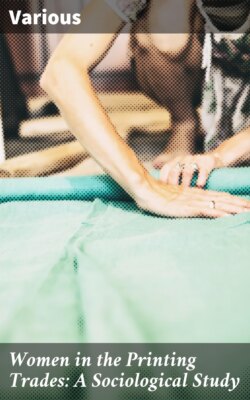Читать книгу Women in the Printing Trades: A Sociological Study - Various - Страница 11
На сайте Литреса книга снята с продажи.
Women as Compositors. Historical.
ОглавлениеThe subdivision of labour which has broken up the original printing "profession" into a score or so of different trades, each minutely subdivided in turn, has been the chief cause of the employment of women in this industry in modern times, although it appears that nuns were engaged as compositors at the Ripoli Monastery Press in Florence towards the end of the fifteenth century,[5] within half a century of the introduction of printing. Only very exceptional women could obtain a footing in a profession which embraced typefounding, ink-making, press-carpentry, composing, folding, and bookbinding. The United States, where, in so many respects, women have stepped in advance of European conditions, boasts of Jenny Hirsch, who carried on a printer's business in Boston about 1690, and during the next two centuries women printers were common in the thirteen States. It was a woman, Mary Catherine Goddard, who printed the first issue of the "Declaration of Independence." The years of the French Revolution also seem to be marked by the number of women engaged in the printing trade, whether owing to the general emancipating impulses of the time or to the increased demand for compositors, is not quite clear. The amiable and eccentric Thomas Beddoes, moved by the interest he took in social affairs, and inspired by the emancipatory movement of his time, had been struck with the opening which the printing trades seemed to offer to women, and gave his "Alexander's Expedition"[6] to a woman of his village, Madely, to set up. "I know not," he wrote in the Advertisement to the book, "if women be commonly engaged in printing, but their nimble and delicate fingers seem extremely well adapted to the office of compositor, and it will be readily granted that employment for females is amongst the greatest desiderata of society." In England, however, the labour of women outside their homes continued to be extremely limited, and the printing trades were confined to men. During the eighteenth century women seem to have been employed in folding and sewing book and news sheets, but they did not come into the trade in any considerable numbers until the nineteenth century was half spent. This was very largely owing to the heavy nature of the work and the long apprenticeship necessary to master the varied details of the craft. The Provincial Typographical Society's first constitution, issued in 1849, shows that at so recent a date the typographical apprentice had to learn "printing and bookbinding" or "printing and stationery."[7] The printing press used in 1800 was practically the same as that used by Gutenberg in 1450.
[5] Printers' Register, August 6th, 1878, quoting Journal für Buchdruckerkunst.
[6] Published in 1792.
